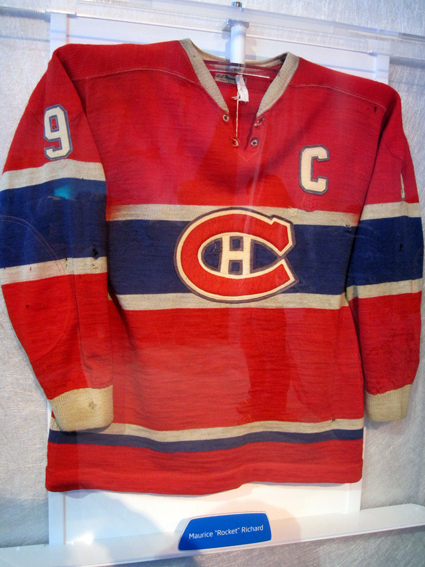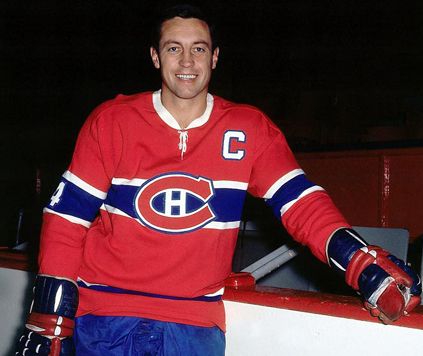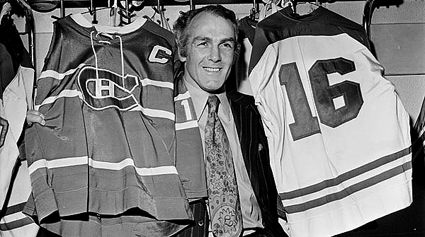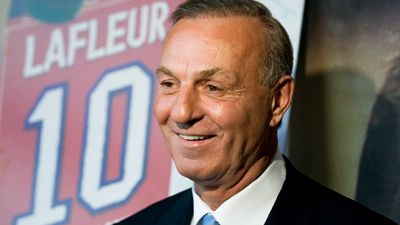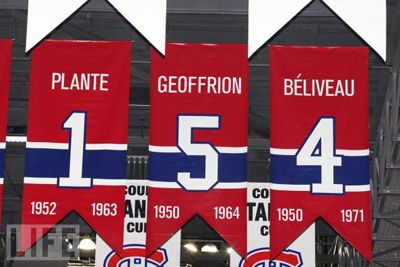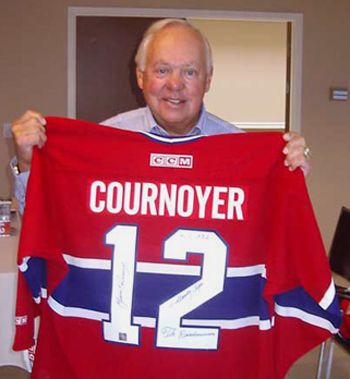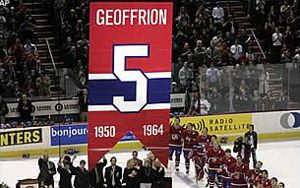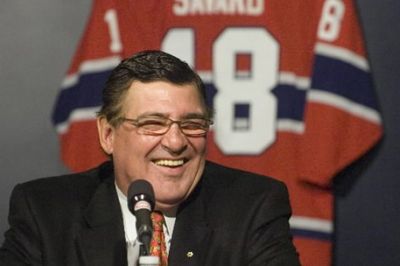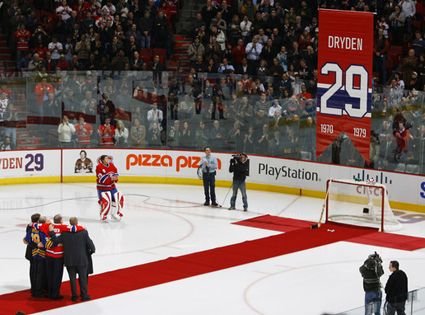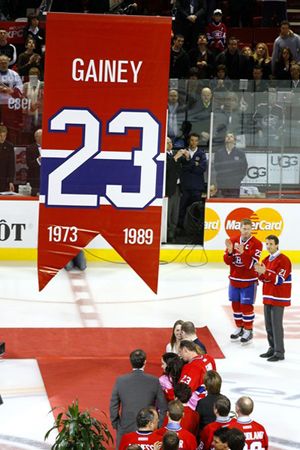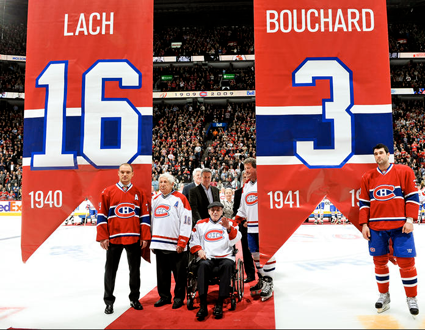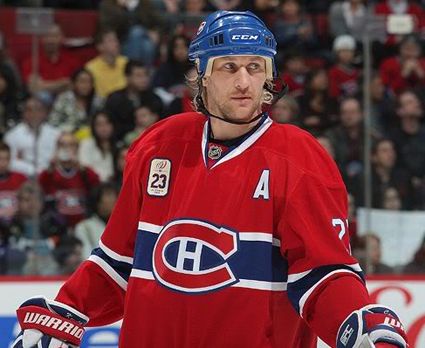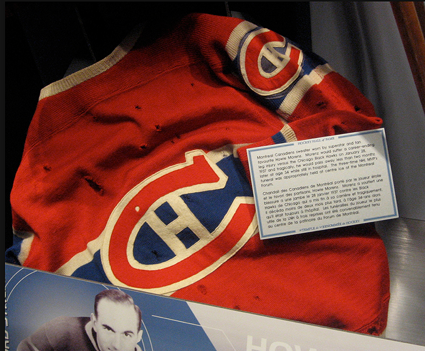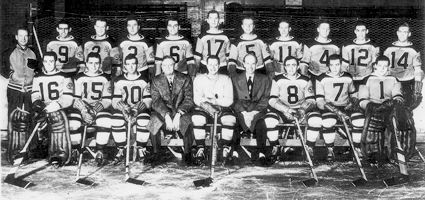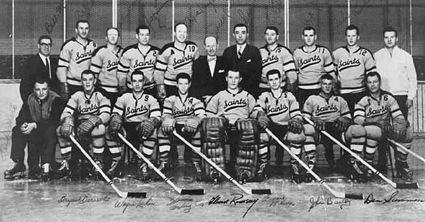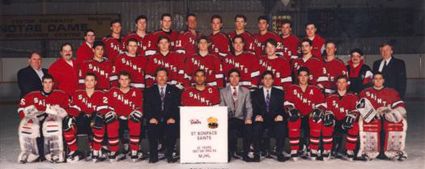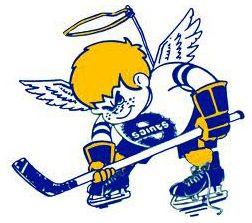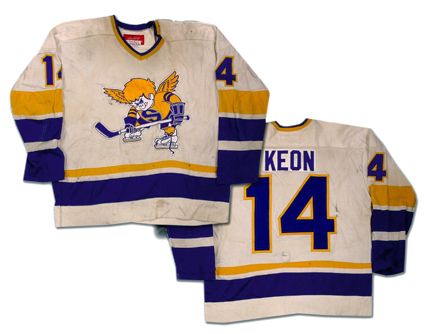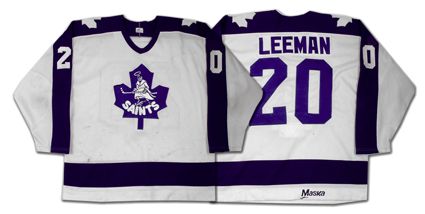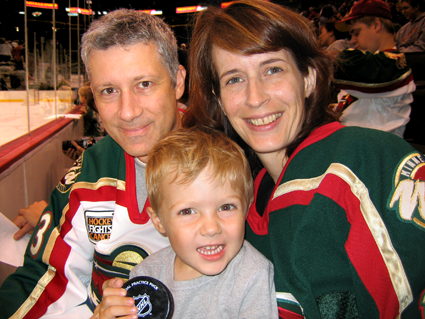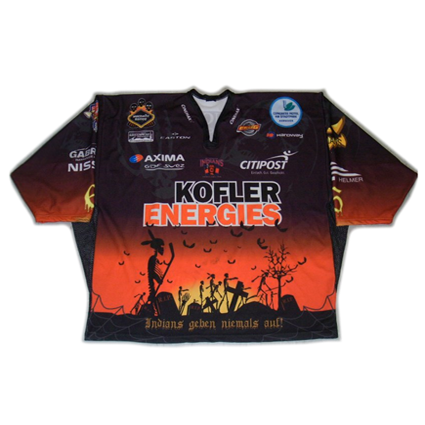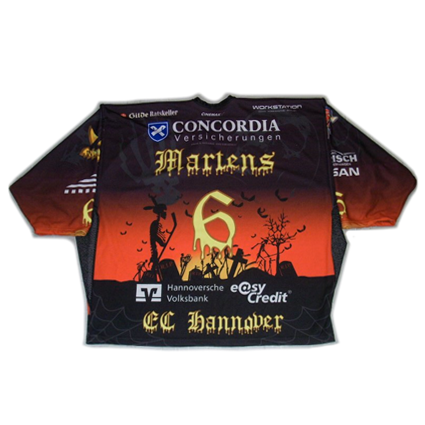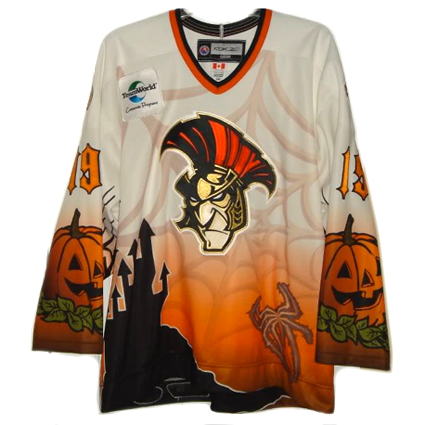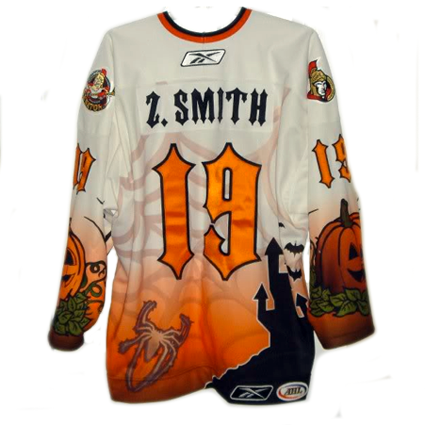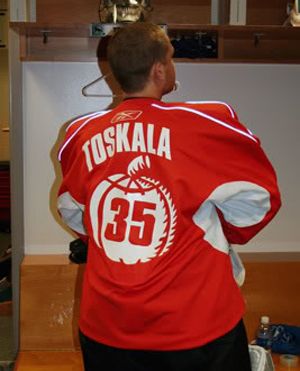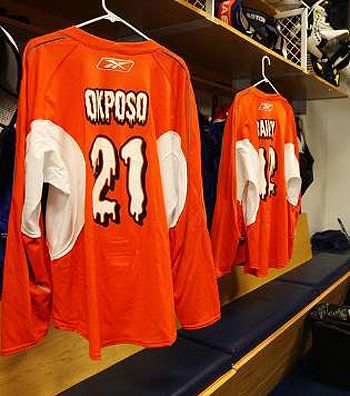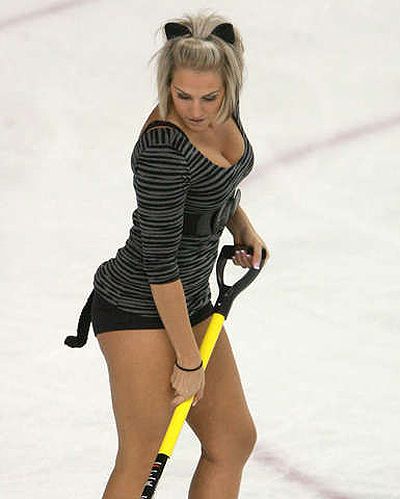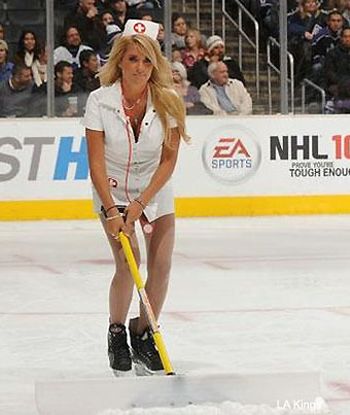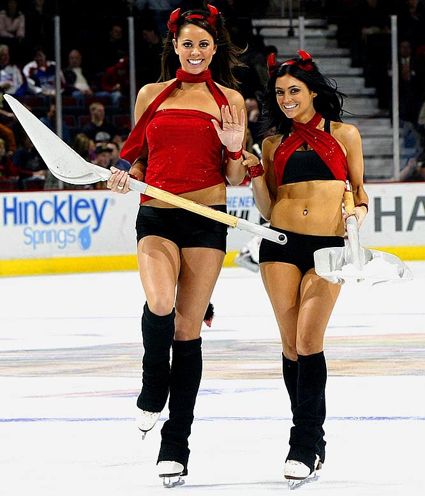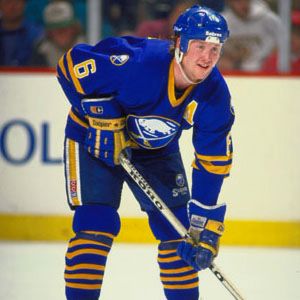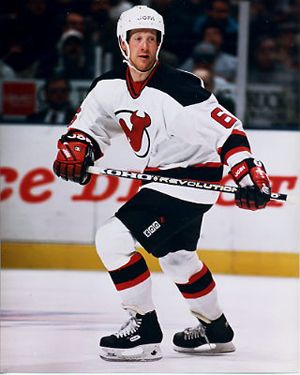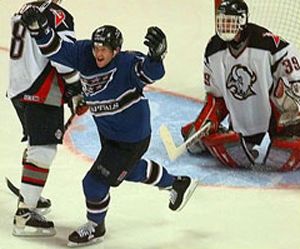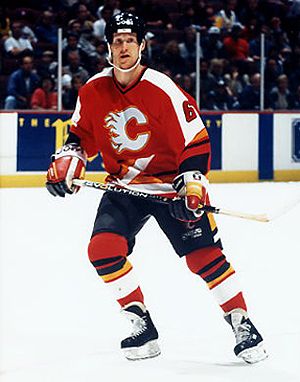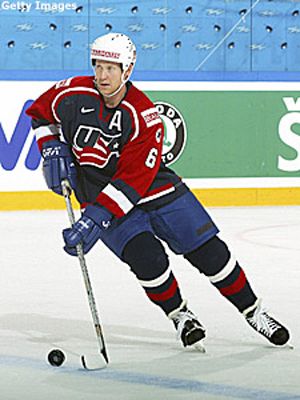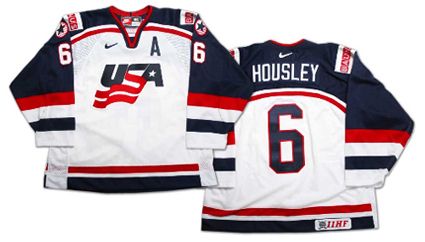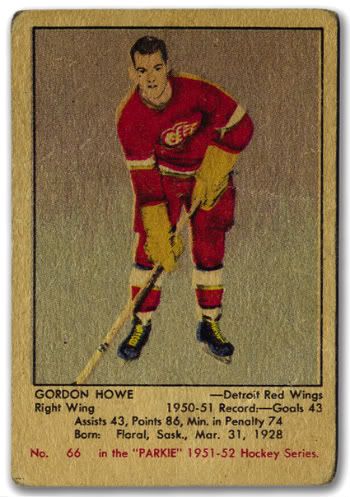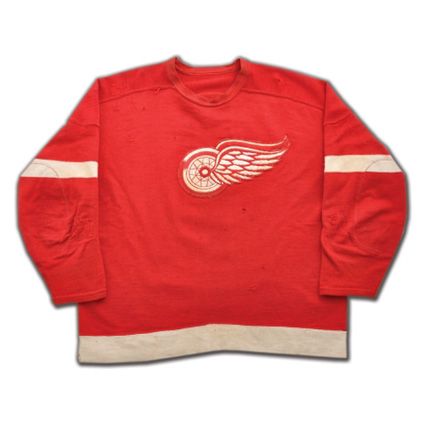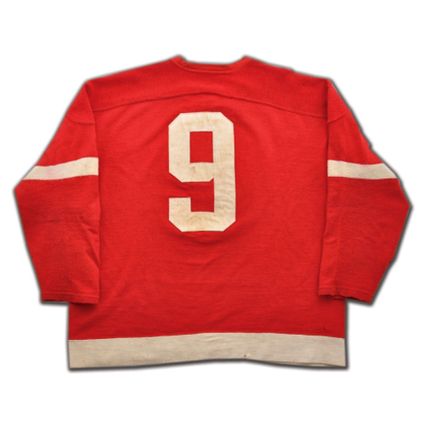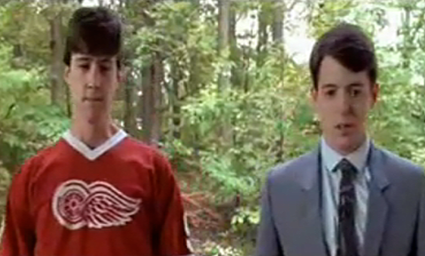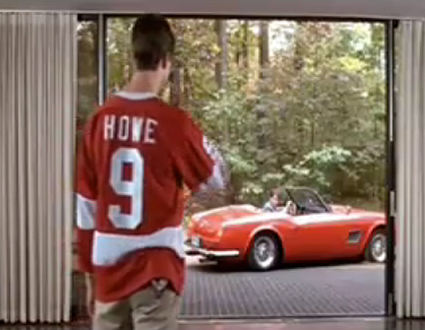Friday, November 2, 2012
1934-35 Montreal Canadiens Howie Morenz Jersey
On this date in 1937, the Montreal Canadiens retired the first sweater in club history, the #7 of the late Howie Morenz, who had died at age 34 following a heart attack while hospitalized for a broken leg suffered in a game five weeks earlier. Morenz had played for Montreal for 12 seasons, winning three Stanley Cups, two Art Ross Trophies and three Hart Trophies.
Howie Morenz's #7 jersey hangs in his locker in the Canadiens dressing room following his death in 1937
The Canadiens would not retire another number for 23 years when the iconic #9 of Maurice Richard was raised to the rafters of the Montreal Forum following Richard's great career, which included him becoming the first player to score 50 goals in 50 games, as well as winning eight Stanley Cups and one Hart Trophy.
Richard's game worn #9 jersey
Eleven years on, the Canadiens would honor the great Jean Beliveau by ensuring no one else would wear his #4. Beliveau would play 20 seasons with Montreal, score over 500 goals, retire as the club's all-time leading scorer and the NHL's leading playoff scorer, play in 14 All-Star Games, win an Art Ross Trophy, a Conn Smythe Trophy and a pair of Hart Trophies on his way to winning ten Stanley Cups and serve as team captain longer than any other player.
Beliveau wearing his #4 captain's jersey
Henri Richard's #16 was next to be set aside on December 10, 1975 after his career which included his record 11 Stanley Cups, which still stands today, and more than 1,000 career points. He also holds the record for Most Games Played in club history and was also a team captain for the Canadiens.
Henri Richard poses with his home and away #16 sweaters
Both Guy Lafleur and defenseman Doug Harvey had their numbers retired in 1985. Lafleur's #10 received the honor on February 16, 1985 after his career, which included five Stanley Cups, 1,246 points which makes him the all-time leader in Canadiens history, over 500 goals, the club records for most goals in a season with 60 and most points in a season with 136. He was also the first player to have 50 goals and 100 points in six consecutive seasons and the fastest player to reach 1,000 career points. He won three Art Ross Trophies, two Hart Trophies, three Pearson Awards and a Conn Smythe trophy while a member of the Canadiens.
Lafleur pictured in front of his #10
#2 Doug Harvey was honored with his sweater retirement early the following season on October 26, 1985. The seven-time winner of the Norris Trophy played 14 seasons with Montreal, winning six Stanley Cups in the process.
It would be another ten years before Jacques Plante's #1 was raised to the rafters. Plante played for Montreal for ten seasons, winning six Stanley Cups, including five in a row. Plante was a winner of the Hart Trophy once and six Vezina Trophies while a member of the Canadiens. He is also credited for wearing the first modern goalie mask.
Plante's banner hangs in the rafters with the other retired banners
Following Plante's jersey retirement, it would be an additional ten years before the Canadiens would honor another player in the same manner.
As part of their Centennial celebrations, the Canadiens announced a series of sweater retirements to take place over the course of the next five seasons. Having retired just one number in 20 years, the Canadiens began to make up for lost time by retiring the #12 for two men, Dickie Moore and Yvan Cournoyer on November 12, 2005. Moore was a two-time Art Ross Trophy winner who once held the single season scoring record with 96 points. In 12 years with the Canadiens, Moore won six Stanley Cups.
Cournoyer skated for the Canadiens for 16 years, including being named team captain. He won a Conn Smythe Trophy and won ten Stanley Cups while with the Canadiens. At the time of his retirement in 1978, he was fourth on the all-time Montreal scoring list.
Cournoyer holds up a signed #12 Canadiens jersey
Bernie "Boom Boom" Geoffrion's #5 came next on March 11, 2006. Geoffrion's colorful nickname is a result of his invention of the slapshot. He played 14 seasons in Montreal, won the Calder Trophy, two Art Ross Trophies, the Hart Trophy and six Stanley Cups. Sadly, he passed away on the day his number was retired.
The ceremony to retire Geoffrion's #5 just hours after his passing
The 2006-07 season saw the retirements of #18 for Serge Savard and #29 for goaltender Ken Dryden. Savard became the first defenseman to win the Conn Smythe Trophy in 1969. He also was named the winner of the Bill Masterton Trophy in 1979 and won eight Stanley Cups in 15 seasons with Montreal.
Serge Savard's #18 rests in the rafters in Montreal
Dryden's career was shorter at eight seasons, but during those years he won the Calder Trophy, the Conn Smythe Trophy (before winning the Calder!), five Vezina Trophies and six Stanley Cups.
Ken Dryden and his family watch is banner being raised in 2007
Larry Robinson and Bob Gainey were honored in 2007-08. Robinson's #19 rose to the rafters in honor of his 17 seasons with Montreal which included two Norris Trophies, a Conn Smythe and six Stanley Cups. In 1976-77 he finished the year with a +120 rating, the second highest in history, and one of only two seasons ever over +100.
Robinson's #19 is retired
Bob Gainey's #23 was retired following his 16 seasons with Montreal which saw him capture four Selke Trophies. While his list of awards is not as lengthy and his point totals not as high as his fellow honored Canadiens, his role as a defensive forward was a key component to the five Stanley Cups Montreal won during Gainey's time with the Canadiens.
Gainey's #23 is raised to the rafters
Patrick Roy was welcomed back into the Canadiens family on November 22, 2008. Roy is the youngest winner of the Conn Smythe Trophy at age 20. In 12 seasons in Montreal, Roy won three Vezina Trophies, four Jennings Trophies, two Conn Smythe Trophies and two Stanley Cups.
Patrick Roy poses with his banner
Finally on the date of the Canadiens centennial, December 4, 2009, the jerseys of both #3 Emile Bouchard and #16 Elmer Lach were surprisingly retired as part of the festivities that evening. Lach played 14 seasons for the Canadiens as part of the famed "Punch Line" with Maurice Richard and Toe Blake. He won two Art Ross Trophies and the Hart Trophy as well as three Stanley Cups. At the time of his retirement in 1954, he was the league's all-time leading scorer.
Bouchard, a defenseman, was captain of the Canadiens for eight seasons during his 15 years with Montreal, which included four Stanley Cup titles. He was the first Quebec-born player to wear the "C" for Montreal. The QMJHL's Defenseman of the Year trophy is named in his honor. At the time of Bouchard's sweater retirement, Canadiens player Ryan O'Byrne was wearing #3, but surrendered it as part of the ceremony, permanently changing to #20.
Lach and Bouchard have their numbers retired in 2009
With the recent run of sweater retirements, the Canadiens have now taken 15 numbers out of circulation in honor of 17 players. Only numbers 6 and 8 remain in the single digits, resulting in an unprecedented number of Canadiens wearing non-traditional jersey numbers higher than #30.
In keeping with the current trend of wearing a patch on the occasion of a jersey retirement, the Canadiens have worn special patches on the players jerseys during the game following their recent jersey retirements.
Alexi Kovalev wearing a patch on the occasion of the retirement of Bob Gainey's #23
Today's featured jersey is a 1934-35 Montreal Canadiens Howie Morenz jersey. This jersey is on display at the Hockey Hall of Fame in Toronto. His was the first of 15 numbers retired by the Montreal Canadiens.
The Canadiens first wore their "CH" logo (with the "H" standing for "hockey") back in 1916 and it appeared on the sleeves for the first time in 1924 when the club wore a globe on the front of their jerseys to symbolize their status as world champions. The following season the logo returned to the chest, but the smaller version of the logo remained on the left sleeve through 1935.
In a wonderful ceremony on the occasion of the clubs 100th Anniversary, many of the men who have had their jerseys retired by the Canadiens took part in a special pre-game warmup and then participated in the remainder of the celebrations that evening, which included the unexpected retirement of Bouchard's #3 and Lach's #16.
Thursday, November 1, 2012
1975-76 Minnesota Fighting Saints Dave Keon Jersey
October 31st, Halloween, is sometimes referred to as "All Hallows Eve", making November 1st "All Hallows", with "hallows" being defined as "to consecrate or set apart as being holy". Thus, All Hallows celebrates all those who have been set apart as being holy by being named to sainthood, which leads to another name for All Hallows - "All Saints' Day".
A search of HockeyDB.com reveals twenty teams named "Saints" at various levels of hockey as far back as 1925 with the original incarnation of the St. Paul Saints of the Central Hockey League. The Saints then moved to the American Hockey Association for four seasons, back to the CHL for four, which included winning the league championship in 1935, and once more back to the AHA for seven seasons until World War II brought a temporary halt to the league. When play resumed in 1945, the Saints were now part of the United States Hockey League until 1955 and took home the championship in 1949.
The 1948-49 USHL champion St. Paul Saints
In 1959 the St. Paul Saints name would be revived with a new franchise in the International Hockey League, which would continue play through 1963 until their name was changed to the St. Paul Rangers to reflect their affiliation with the NHL's New York Rangers. This edition of the Saints was quite successful, appearing in the Turner Cup Finals three consecutive seasons, winning championships in both 1960 and 1961 and having their reign ended in 1962.
The 1960 IHL Champion St. Paul Saints
Next on the scene was the St. Catharines Saints in 1940 in the Ontario Hockey Association in Canada. That club lasted only two seasons, but the name was revived in 1982 when a new club joined the American Hockey League in 1982. That club stayed for four seasons prior to a relocation to Newmarket, Ontario where they were now known as the Newmarket Saints until 1991. After another relocation resulted in a name change, followed by yet another in 2005 which currently has them known as the Toronto Marlies.
A little known club in Minnesota called the Hibbing Saints played for one season in the Northern Hockey League. The fourth Saints franchise was the Sherbrooke Saints of the Quebec Senior Hockey League from 1949 to 1954.
The St. Boniface Saints had a long run in the Manitoba Junior Hockey League from 1967 to 2001 before new owners renamed them the Winnipeg Saints where they continue to play in Canadian Tier II Junior "A" hockey.
The 1992-93 St. Boniface Saints
Also formed in 1967, the Windsor St. Clair Saints played in the Ontario Colleges Athletic Association and dominated with championships in 1968, 1969, 1970, 1973, 1975, 1976, 1977 and 1979. They also won the Canadian Colleges Athletic Association National Championship in 1976.
After an extended break from competition, the St. Clair Saints returned in 2001 and won the OCAA championship in 2002 and 2003. Following the demise of the OCAA, the Saints eventually joined Major League Hockey, playing against Senior AAA level teams from 2006 to 2008 before ceasing operations.
The St. Claire Saints pay a hospital visit in 2008
The Laval Saints of the Quebec Major Junior Hockey League lasted but one season in 1969-70.
The next club to arrive on the scene with the Saints name did so with a twist. As founding members of the World Hockey Association in 1972 based in St. Paul, Minnesota, the new club elected to call themselves the Minnesota Fighting Saints. They created one of the best logos hockey has ever seen, which has been copied again and again since then. The Fighting Saints also played a firey, uptempo brand of hockey with plenty of fisticuffs and occasional mayhem thrown in to live up to the team name.
Competing with the NHL's Minnesota North Stars, who were in a down period on the ice at the time, the always competitive Fighting Saints captured the hearts of the Minnesota hockey fans and played to several record setting capacity crowds of over 17,000 at their brand new St. Paul Civic Center on the current site of the Minnesota Wild's Xcel Energy Center.
The 1973-74 Minnesota Fighting Saints
The Fighting Saints lasted four seasons in the unstable WHA and never missed the playoffs or had a losing record. After the original blue-clad WHA Fighting Saints folded during the 1975-76 season, the Cleveland Crusaders relocated to St. Paul for 1976-77 and adopted the Fighting Saints name and logo, but changed their primary color to red to differentiate themselves from the original club. This version of the Fighting Saints lasted only 42 games before also calling it quits.
Surprisingly, there haven't been more teams from St. Louis named the Saints, but there was one such club, the St. Louis Saints, which competed in the Continental Hockey League for two years starting in 1974.
The tenth Saints club, a junior hockey team from Ecorse, Michigan named the Paddock Pool Saints was active from 1975 to 1984 in the Great Lakes Junior Hockey League. The St. Albert Saints (1977-2004) were members of the Alberta Junior Hockey League, not to be confused with the Saskatchewan Junior Hockey League's Prince Albert Saints, who played in 1980-81.
Despite their short life, the Minnesota Fighting Saints popularity influenced several subsequent teams at various levels, including the Dubuque Fighting Saints (1980-2001) of the United States Hockey League, the Danville Fighting Saints (1986-1989) of the All American Hockey League and the St. Paul Fighting Saints (1992-93) of the American Hockey Association. A new version of the Dubuque Fighting Saints began play in the USHL in 2010 and continue to play today, having won a championship in their first season of play in 2011.
Going overseas, the Glasgow Saints of Scotland competed in the British Hockey League during the 1990-91 season, but failed to survive beyond that.
The San Angelo Saints who were members of the Central Hockey League from 2002-2005 and the Spruce Grove Saints of the Alberta Junior Hockey League are the relocated St. Albert Saints a franchise which can be traced back to 1963 with several different names. Spruce Grove is continues to play to this day.
The 2009-10 Spruce Grove Saints
Finally the the New York Saints of the Metropolitan Junior Hockey League arrived in 2006.
Today's featured jersey is a 1975-76 Minnesota Fighting Saints Dave Keon jersey. After Keon came to an agreement to join the Ottawa Nationals of the fledgling WHA in 1972, the deal fell apart and he signed a three year contract to remain in Toronto and led the team in goal scoring in 1972-73, which included his 297th goal as a Maple Leaf, passing George Armstrong and Frank Mahavolich as the franchise's all-time leading goal scorer.
Having fallen out of favor with Maple Leaf's owner Harold Ballard by the end of his contract, Keon jumped to the rival WHA and signed with the Minnesota Fighting Saints. When the Fighting Saints folded, Keon was unable to return to the NHL because the Maple Leafs still held his NHL rights and owner Ballard wanted too steep a level of compensation from any NHL club signing him, effectively locking Keon out of the NHL.
With only the WHA as an option, Keon signed with the Indianapolis Racers for the remainder of the season. He was traded to the new incarnation of the Minnesota Fighting Saints for the following season, only to see that version of the franchise again fold during before the completion of the season. He once more found some stability when he joined the WHA's New England Whalers, where he would play for the remainder of his career, three seasons in the WHA and three more finally back in the NHL following the merger in 1979.
It was during the 1979-80 season that Keon, then 40 years old, was occasionally on a line with both Gordie Howe (age 50) and Bobby Hull (age 41). When both Howe and Hull retired, Keon was the oldest player in the NHL for his final two seasons before retiring after the 1981-82 season at age 42.
Keon's final totals were 396 goals and 590 assists for 986 NHL points and another 102 goals and 189 assists for 291 points in the WHA, the Calder Trophy, two Lady Byng Trophies, a Conn Smythe Trophy, eight NHL All-Star Game appearances and four Stanley Cups as well as being inducted into the Hockey Hall of Fame in 1986.
If the Fighting Saints jersey appears familiar at first glance, is probably is, as the Fighting Saints minor league affiliate the Johnstown Jets was the inspiration for the Charlestown Chiefs of the famed move "Slap Shot", and the movie Chiefs wore jerseys of the same color and striping template as Johnstown, who mimicked the jerseys of their parent club, the Fighting Saints.
This jersey was actually not the original Fighting Saints jersey, as they began play with jerseys featuring a large "S" logo before a second set of jersey featuring the "Little Saint" logo was put into use.
Bonus Jersey: Today's bonus jersey is a 1984-85 St. Catharines Saints Gary Leeman jersey. Leeman was a ten year member of the Toronto Maple Leafs of the NHL, but did play 7 and then 25 games over two seasons with St. Catharines of the AHL early in his career. Leeman would later go on to win a Stanley Cup with the Montreal Canadiens in 1993 and score 466 points in 667 NHL games.
This jersey clearly reflects the then current style of the Saints parent club, the Toronto Maple Leafs. While copying the parent club's jersey style was the norm back then, many minor league clubs have learned the value of having their own separate identity when it comes to their own income through sales of unique merchandise and jerseys.
Today's video segment is a peek into the crazy world of the Minnesota Fighting Saints of the WHA, when one of the players beat up his own coach!
This second video is a highlight film of the Fighting Saints first season of 1972-73. Notice the gold alternate jerseys with the original "S" logo, none of which are known to have survived, as the logos were removed and they were handed down to a local high school who shared the same colors.
Once the Little Saint logo appeared on their jerseys, they Fighting Saints limited themselves to just home white and road blue jerseys.
Another thing to be aware of are the unique clear boards used in the St. Paul Civic Center, which allowed fans a view of the puck at all times, particularly those fans in the first several rows of seats, which were set back from the boards by a fair distance due to the round layout of the Civic Center.
If you are interested in some rare St. Paul Saints for Minnesota Fighting Saints jerseys, our friends at VintageMinnesotaHockey.com have a series of excellent reproductions of not only the WHA's Minnesota Fighting Saints, more accurate than anything found anywhere else online, but also a series of St. Paul Saints jerseys from the minor league club from the 1930's to the 1960's. Just do a search for "Saints" to view your options.
P.S. Happy Birthday to Kelly, without whose patience and understanding this blog would not be possible.
Labels:
Keon Dave,
Minnesota Fighting Saints
Wednesday, October 31, 2012
Happy Halloween!
Quite often in the minor leagues teams will create special one-off jerseys for various special occasions such as theme nights, tribute nights or holidays, such as Valentine's Day, New Year's Eve or today's annual observation of Halloween.
The jersey production method of dye-sublimation, which allows for all manner of intricate details to be printed onto jerseys, lends itself perfectly to they eye-catching, or occasionally eye-searing, special occasion jerseys.
Two of the best Halloween jerseys we've ever seen are the efforts by the 2009-10 Hannover Indians of the 2nd Bundesliga, the second level of German professional hockey, in 2009 and the 2008 creation of the Binghamton Senators of the American Hockey League.
This 2009-10 Hannover Indians Halloween jersey, as worn by American Nick Martens, is a downright spooky affair, featuring a series of skeletons, some with feathers on their heads in keeping with the team's nickname, wandering through a graveyard as a large flock of bats circles overhead at sundown. The primary skeleton even sports a hockey stick, showing some thought went into this design and it just wasn't some clip art chosen because it fit the Halloween theme.
Another well chosen element was the choice of the always creepy but fun font "Blood of Dracula" for the player's names and numbers, as well as the team name on the back and the motto on the front of the jersey reads "Indians geben niemals auf!", which translates to "Indians never give up!", which is additionally appropriate for the walking dead.
Fortunately for the jersey designer, the club's main sponsor, Kofler Energies, just happens to have the appropriate orange and black as their corporate colors!
The other favorite jersey on our list is the 2008-09 Binghamton Senators Halloween jersey, as worn by center Zack Smith, who is currently playing for the parent club, the Ottawa Senators of the NHL.
Rather than making the expected black jersey, the Senators opted for a lighter jersey which features many of the usual halloween icons, such as the jack o' lanterns on the lower sleeves, a spooky castle with circling bats and a large spider on the lower body, whose subtle web covers the majority of the jersey. The look is completed by choosing the font Ironwood, which evokes thoughts of a gothic dungeon in a spooky castle.
Even the team's main crest doesn't seem out of place, as the angry, cartoonish Senator on the front is rather scary looking and the colors aren't too far off from the color palette of the rest of the package.
While many of the top professional leagues have not embraced the use of special occasion jerseys for games, at times NHL clubs have been known to occasionally create a unique set of jerseys worn in pre-game warmups, like those worn by the San Jose Sharks in 2007 and the New York Islanders in 2009, which were later auctioned off for charity, with John Tavares' jersey raising $1,701.79.
The San Jose Sharks 2007 Halloween themed warmup jersey
The New York Islanders 2009 Halloween themed warmup jersey
The Sharks have once more created a special Halloween jersey this year, and wore it in practice. They jerseys were then auctioned off on October 27th and 30th, with one remaining one being sold through NHL Auctions.
The San Jose Sharks 2010 Halloween themed practice jersey
Even if clubs in the NHL choose not to wear special jerseys on this day, it's at least an opportunity for their ice girls to have some fun and dress up in costume.
Today's video segment features the man who did more to make the goalie mask famous than Jacques Plante, Jason Voorhees in a surreal interview with Arsenio Hall.
Next, the Florida Panthers Ice Dancers performance from Halloween 2009. Full credit must be given for doing those high kicks on ice without wiping out. Just how do they do that?
Here's a quick video with some of the best costumes worn to games by NHL fans.
Next, Toronto Maple Leafs general manager Brian Burke and crew perform a Halloween favorite with the help of "The Monster", Jonas Gustavsson.
Next, Toronto Maple Leafs general manager Brian Burke and crew perform a Halloween favorite with the help of "The Monster", Jonas Gustavsson.
Finally, a tribute to the Boogeyman on Halloween.
Tuesday, October 30, 2012
2005 United States National Team Phil Housley Jersey
Phil Housley is one of the rare NHL players who never played a single game in the minors. He was drafted 6th overall in the 1982 NHL Entry Draft out of South St. Paul High School by the Buffalo Sabres.
He was a model of dependability for Buffalo, playing no less than 72 games, scoring a minimum of 15 goals, with a high of 31 in 1983-84, and totaling between 62 and 81 points for each of his eight seasons with the Sabres.
He was sent to the Winnipeg Jets in a deal that saw Dale Hawerchuk go to Buffalo and spent three seasons in Winnipeg cranking out the exact same kind of numbers he had for the Sabres.
He was traded to the St. Louis Blues for the 1993-94 season, but his time there was brief, appearing in only 26 games in St. Louis before once more being traded, this time to the Calgary Flames, who would then send him to the New Jersey Devils in 1995-96.
He was traded to the St. Louis Blues for the 1993-94 season, but his time there was brief, appearing in only 26 games in St. Louis before once more being traded, this time to the Calgary Flames, who would then send him to the New Jersey Devils in 1995-96.
He then signed as a free agent with the Washington Capitals for the 1996-97 season, in which he would play in his 1000th game on this date in 1996. Housley would go on to set the unfortunate record of playing the most games in history without ever winning the Stanley Cup with 1,495. The closest Housley came to winning the cap was the following season with the Capitals when they made the 1998 finals.
He made a return to Calgary for the next three seasons followed by two as a Chicago Blackhawk who traded him to the Toronto Maple Leafs, his eight and final team, where he would play in just a single regular season game and three playoff games to end his 21 year career.
When Housley retired in 2003, he held the record for most games played by an American, as well as the record for most career points by an American, no mean feat considering he spent the majority of his career playing defense, although he did skate at forward as well. His final statistical totals were 1495 games played, 338 goals and 894 assists for 1232 points.
He was inducted into the Buffalo Sabres Hall of Fame in 2007 and the United States Hockey Hall of Fame in 2004.
Today's featured jersey is a 2005 United States National Team Phil Housley jersey. Internationally, Housley played for the United States in the 1984 and 1987 Canada Cups, the World Championships in 1982, 1986, 1989, 2000, 2001 and 2003 and captured a gold medal in the 1996 World Cup of Hockey.
This style jersey made it's debut at the 2002 Olympics in Salt Lake City and was used during the World Juniors, World Championships, Olympics and 2004 World Cup, remaining in use through the 2005 World Junior Tournament.
This jersey sports Bauhaus sponsor patches on the shoulders, which is a unique element of jerseys worn during the World Championships.
This jersey sports Bauhaus sponsor patches on the shoulders, which is a unique element of jerseys worn during the World Championships.
Here is the rock solid Housely absorbing a blow from Sergei Fedorov and quickly skating away while Fedorov is shaken by the collision.
Here Housely plays for the United States in the 1984 Canada Cup versus Dominik Hasek and Czechoslovakia and gets an assist with a blast from the point.
Once more Housely gets an assist with a blast from the point versus Hasek, only this time while playing for the Capitals and wearing the unfamiliar #96.
Labels:
Housley Phil,
USA
Monday, October 29, 2012
1954-55 Detroit Red Wings Gordie Howe Jersey
On this date way back in 1947 Gordie Howe, then of the Detroit Red Wings wore #9 for the first time. As a rookie in 1946-47, Howe had worn #17, but before the start of the 1947-48 season the previous wearer of #9 for the Red Wings, Roy Conacher was sold to the Chicago Blackhawks.
Red Wings trainer Lefty Wilson encouraged Howe to switch to #9, pointing out that a lower sweater number meant a lower and more comfortable bed on the trains then used for travel by all the NHL teams, as the sleeping berths were assigned according to the player's numbers.
Also on this date in 1970, 23 years later, Howe became the first player in NHL history to reach 1,000 career assists during the Red Wings 5-3 victory over the Boston Bruins when he recorded two assists, plus a goal, at the Olympia in Detroit. Before you ask, he did not have a fight that night to complete a "Gordie Howe Hat Trick".
Howe would finish his career with 975 goals and 1383 assists for 2358 points combined from his time in both the NHL and his six seasons in the WHA.
Today's featured jersey is a 1954-55 Detroit Red Wings Gordie Howe jersey. Howe and the Red Wings would win their third Stanley Cup of Howe's career following the 1954-55 season. This sweater can be traced back to that era by the lack of sleeve numbers, which did not appear until later thanks to the advent of television coverage.
Bonus(?) Jersey: Following the iconic Red Wings jersey of all time, we must unfortunately present one of the worst. This is Cameron Frye's Detroit Red Wings Gordie Howe jersey as worn in the movie "Ferris Bueller's Day Off".
The first issue we have with this jersey is the main crest on the front which is rotated more than any main crest in over 90 years of Red Wings history. Perhaps the crests used to be occasionally sewn on at less of an angle than we have become accustomed to, as evidenced by today's featured jerseys, but we've never seen one do a wheelie before.
Or is it suffering from a flat tire?
The main problem we have with this jersey is, of course, the name on the back.
Howe, in his entire time in Detroit, never wore a jersey with his name on the back as the Red Wings did not use names on the backs of their white jerseys until 1973 and they did not appear on the red jerseys until 1977, a full seven seasons after Howe had left Detroit. Even then, it's not vertically arched like the names on the backs of Red Wings jerseys have been since 1982 and the movie was released in 1986.
And let's not forget the fact Cameron wore the jersey with khaki Dockers and loafers! Please.
Then there is the fact he spent the entire day in the city of Chicago, home of your Blackhawks, parading around in a hated Red Wings jersey. They were lucky to have escaped Wrigley Field with their lives...
Labels:
Detroit Red Wings,
Ferris Bueller,
Howe Gordie
Subscribe to:
Comments (Atom)


